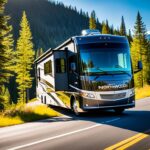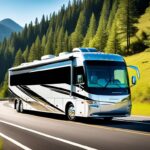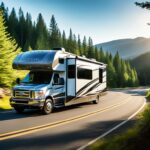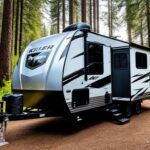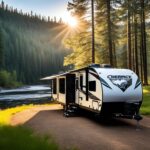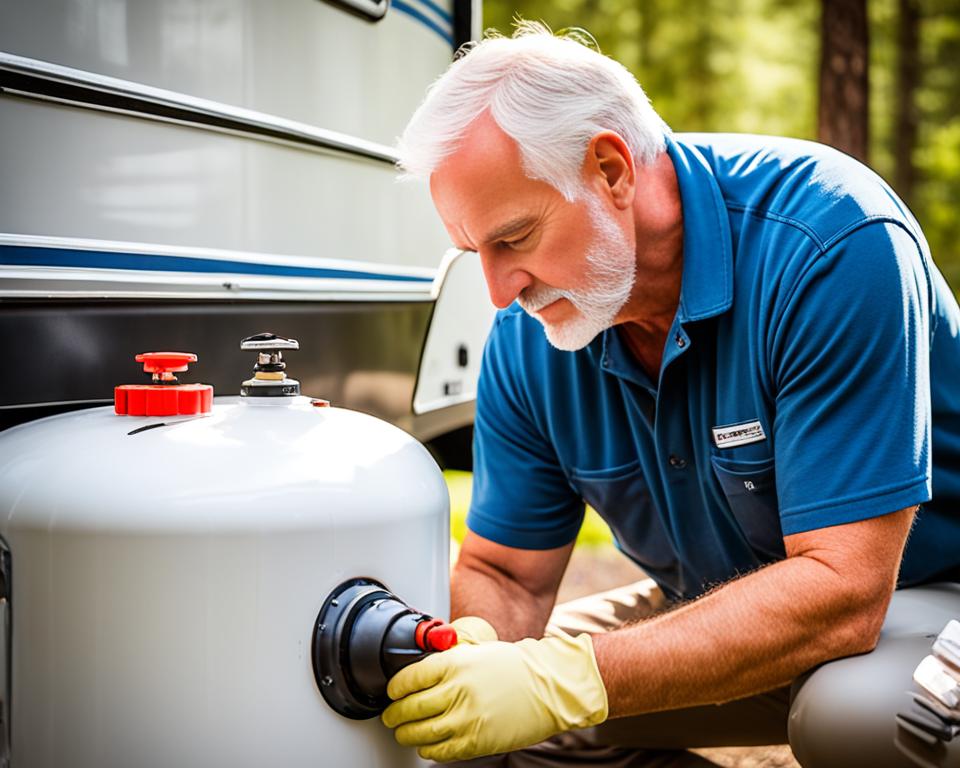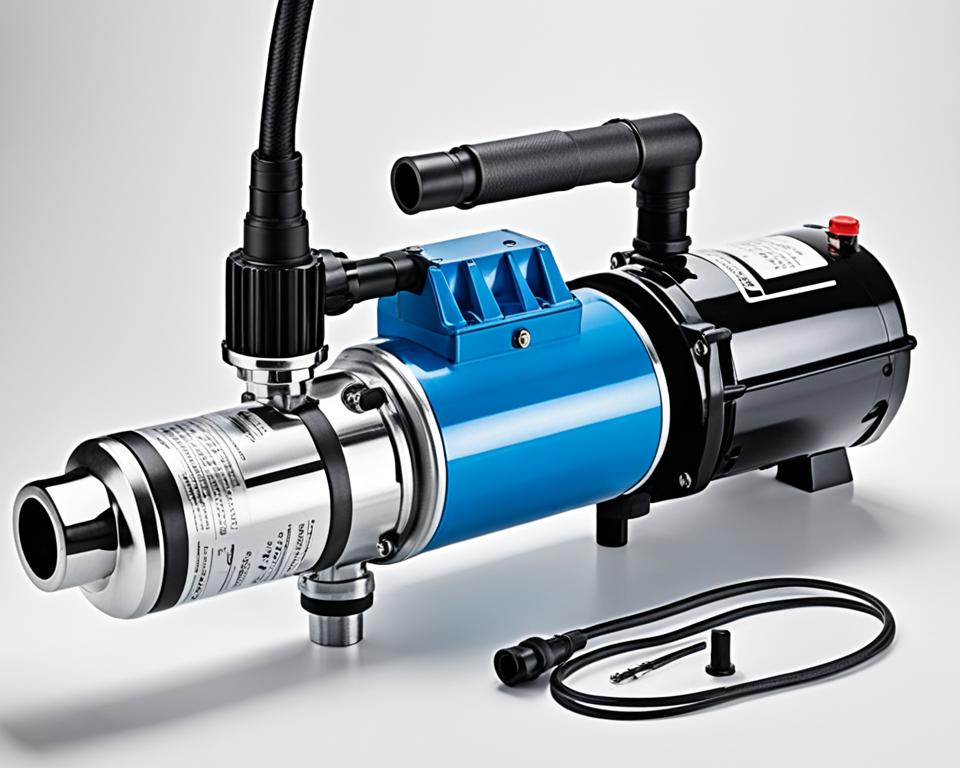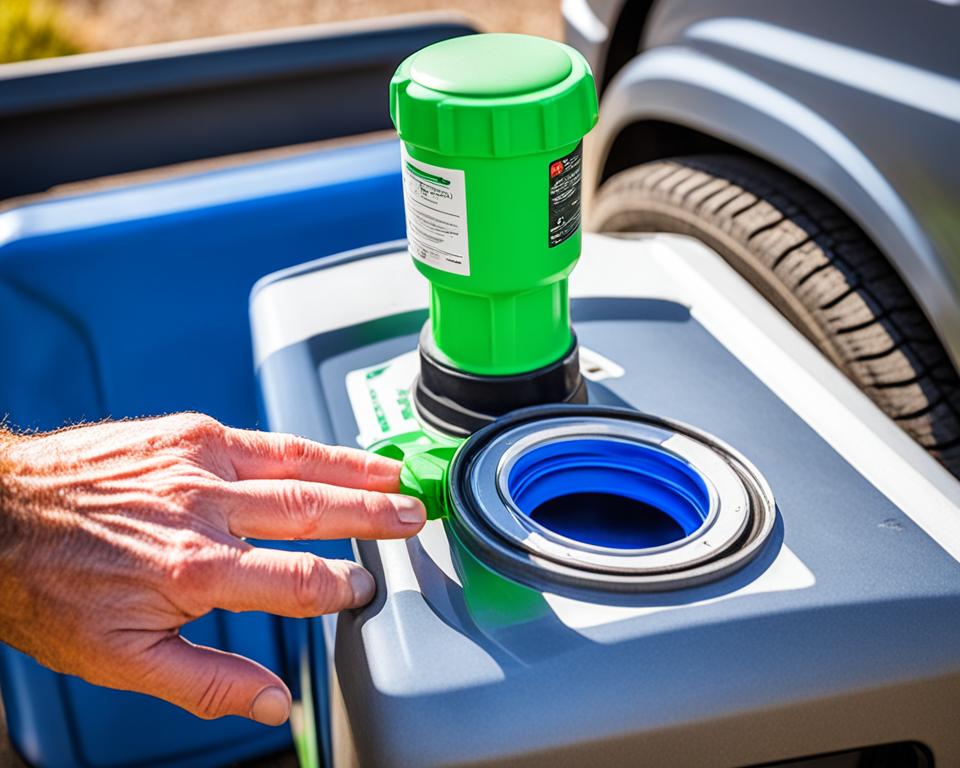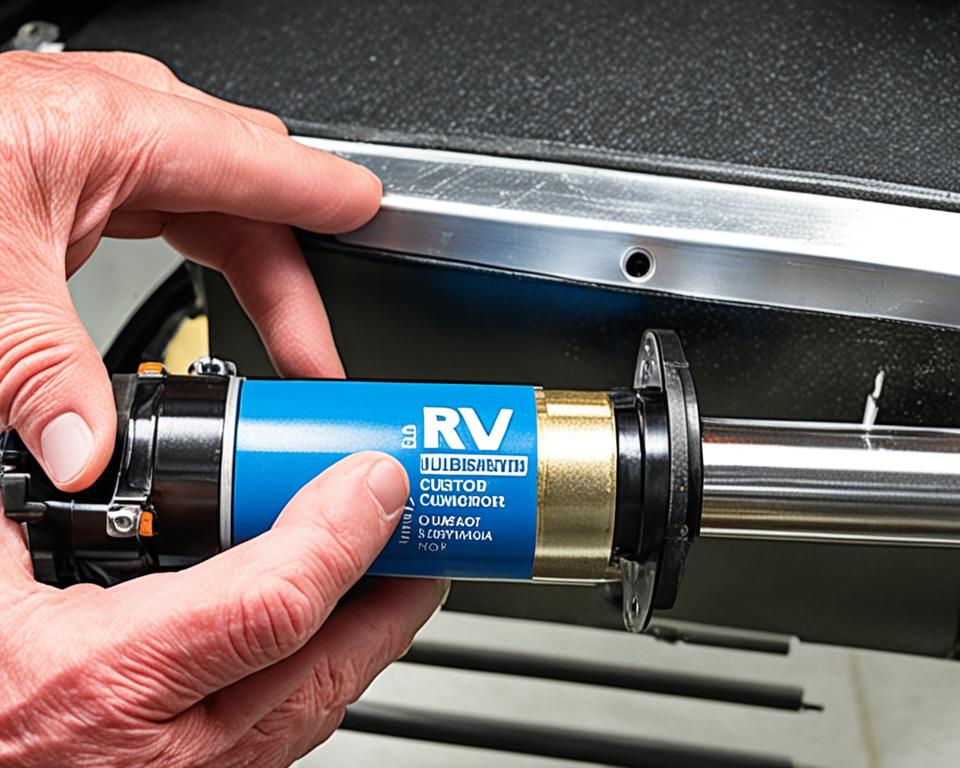Regular maintenance is crucial for keeping your RV’s suspension in top condition and ensuring a smooth and safe journey on the road. Neglecting maintenance can lead to costly repairs and reduce the lifespan of your RV. By following a comprehensive maintenance checklist, you can keep your RV suspension well-maintained and extend its longevity.
Key Takeaways:
- Regular maintenance is essential for the longevity and optimal performance of your RV suspension.
- Proper maintenance prevents accidents, breakdowns, and costly repairs caused by suspension issues.
- Pre-trip maintenance checks, monthly maintenance tasks, and seasonal maintenance are all important for preserving your RV suspension.
- Even if you’re a part-time RVer or a beginner, following a maintenance checklist will help you keep your suspension system in good condition.
- Understanding the basics of RV suspension maintenance and addressing common issues promptly ensure a smooth RVing experience.
Why Is RV Suspension Maintenance Important?
Proper maintenance of your RV suspension is essential for several reasons. First, it ensures your safety on the road by preventing accidents and breakdowns caused by suspension issues. Second, regular maintenance helps maintain the performance and efficiency of your suspension system, providing you with a smooth and comfortable ride. Lastly, proper maintenance increases the longevity of your suspension components, saving you money on costly repairs or replacements.
Regular RV suspension maintenance plays a crucial role in ensuring your safety while traveling in your RV. By keeping your suspension system in good condition, you significantly reduce the risk of accidents and breakdowns caused by suspension-related issues. A malfunctioning suspension can lead to unstable driving conditions, poor handling, and increased stopping distances, compromising the overall safety of your RV.
Maintaining your RV suspension also helps optimize its performance and efficiency. A well-maintained suspension system ensures a smooth and comfortable ride, minimizing vibrations, bumps, and road noise. It helps absorb the impact of uneven and rough roads, improving your overall driving experience. Additionally, a properly functioning suspension system helps distribute weight evenly across all tires, enhancing tire traction and extending tire life.
Furthermore, regular maintenance allows you to identify and address any potential problems before they escalate into major issues. By inspecting and lubricating key components, such as bushings, shackles, and equalizers, you can prevent premature wear and damage, reducing the likelihood of costly repairs or replacements. Routine inspections also help identify signs of wear, such as leaks, cracks, or corrosion, enabling you to take immediate action and avoid further damage.
“Proper maintenance of your RV suspension is not just about prolonging its lifespan and preventing expensive repairs; it’s about ensuring your safety on the road and enjoying a smooth, comfortable ride.”
Regular maintenance intervals will vary depending on various factors, including how often you use your RV and the specific manufacturer’s recommendations. However, it is generally recommended to inspect and service your RV suspension at least once a year or before embarking on a long trip.
Investing time and effort in RV suspension maintenance not only provides peace of mind while traveling but also ensures the longevity and optimal performance of your suspension system. By following a regular maintenance schedule, conducting thorough inspections, and addressing any issues promptly, you can enjoy a safer, more comfortable, and worry-free RVing experience.
| Benefits of RV Suspension Maintenance |
|---|
| Enhanced safety on the road |
| Improved ride comfort |
| Optimized suspension performance |
| Extended lifespan of suspension components |
| Reduced risk of costly repairs or replacements |
Pre-Trip RV Suspension Maintenance
Before embarking on your next RV adventure, it’s crucial to ensure that your RV suspension is in optimal condition. Performing pre-trip maintenance checks can help prevent any issues on the road and ensure a smooth and safe journey.
Checklist for Pre-Trip RV Suspension Maintenance:
- Check Tire Pressure: Proper tire pressure is essential for a well-functioning suspension system. Use a reliable tire pressure gauge to measure the pressure of each tire, including the spare. Adjust the tire pressure as needed to match the manufacturer’s recommendations.
- Inspect Tires and Wheels: Carefully inspect your tires for any signs of damage or wear, such as cracks, bulges, or uneven tread wear. Check the lug nuts on your wheels to ensure they are properly tightened.
- Electrical Connection: Check the electrical connection from your RV to the tow vehicle. Ensure that the wiring is secure, free from any damage, and functioning properly. Test the brake lights, turn signals, and running lights to ensure they are working correctly.
By following this pre-trip RV suspension maintenance checklist, you can minimize the risks of experiencing suspension-related issues during your journey. Remember, proper maintenance is essential for a safe and comfortable RVing experience.
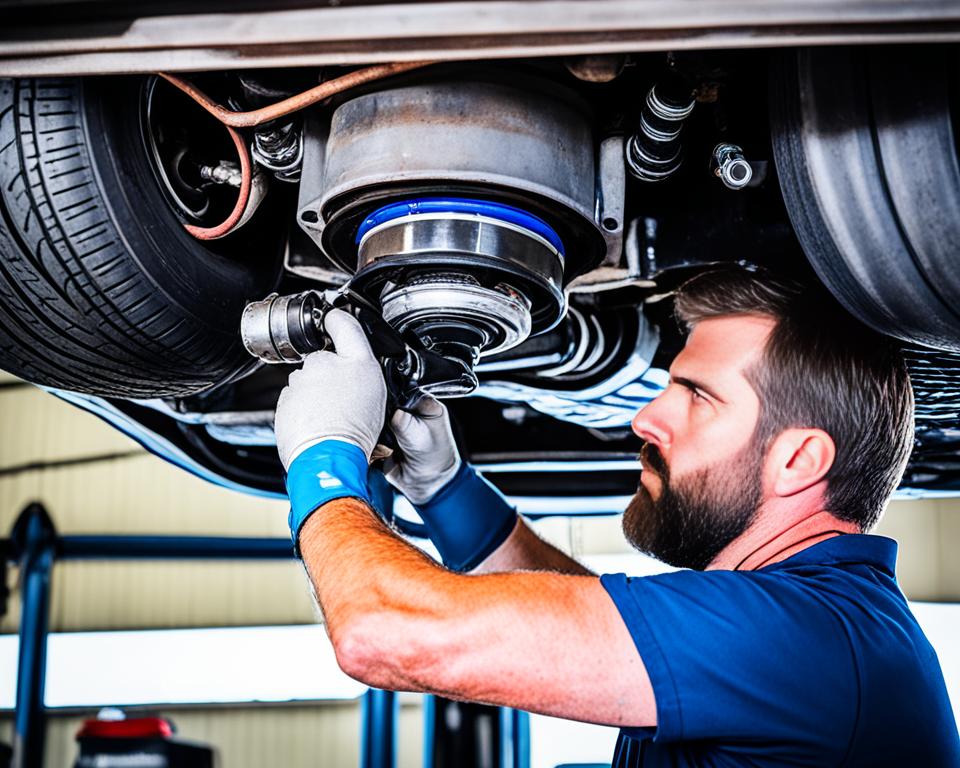
Performing pre-trip RV suspension maintenance not only ensures your safety on the road but also enhances the overall performance of your RV suspension system. By taking the time to check tire pressure, inspect tires and wheels, and ensure proper electrical connections, you can have peace of mind knowing that your suspension is in optimal condition for your upcoming adventure.
Monthly RV Suspension Maintenance
Regular monthly maintenance is essential for ensuring the longevity and optimal performance of your RV suspension. By following a routine maintenance checklist, you can identify and address any issues before they become major problems. Here is a comprehensive checklist for monthly RV suspension maintenance:
- Inspect seals and gaps: Check for any gaps or cracks in your seals and fill them appropriately to prevent air and water penetration.
- Clean and lubricate slide-outs: Regularly clean and lubricate your slide-outs to ensure smooth operation and prevent any sticking or jamming.
- Check batteries and fluid levels: Regularly inspect the batteries in your RV and ensure they are properly charged. Additionally, check fluid levels such as coolant, brake fluid, and power steering fluid to ensure they are at the recommended levels.
- Service the generator: Run and service your RV’s generator according to the manufacturer’s instructions. This will help maintain its performance and extend its lifespan.
- Clean the A/C unit: Regularly clean the air conditioning unit to remove any dirt or debris that can affect its efficiency. This will help ensure a comfortable interior temperature during your travels.
- Test detectors: Test the smoke detectors, carbon monoxide detectors, and LP gas detectors in your RV to ensure they are functioning properly. Replace batteries if needed.
By following this monthly maintenance checklist, you can keep your RV suspension in excellent condition and enjoy a smooth and safe journey on the road.
“Regular monthly maintenance is crucial for keeping your RV suspension in top condition and ensuring a smooth and safe journey on the road.”
Seasonal RV Suspension Maintenance
Seasonal RV suspension maintenance is crucial for keeping your suspension system in optimal condition throughout the year. By performing specific tasks each season, you can protect and maintain your RV suspension, ensuring a smooth and safe journey regardless of the weather conditions or environments you encounter.
Spring RV Suspension Maintenance
In the spring, it’s important to focus on refreshing and rejuvenating your RV suspension after the winter months. Start by thoroughly washing and waxing the exterior of your RV to remove any dirt, grime, or road salt that may have accumulated. This will help protect the suspension components from corrosion and extend their lifespan.
Next, deep clean the interior of your RV, paying attention to areas that may have been neglected during the winter. This includes vacuuming carpets, wiping down surfaces, and cleaning the upholstery. Regular cleaning not only improves the aesthetics but also helps maintain the overall condition of your RV suspension.
Additionally, spring is the perfect time to inspect and clean or replace your awning fabric. Over time, awning fabric can accumulate dirt, mold, or mildew, which can affect its functionality and cause damage to your RV suspension if not addressed promptly.
Summer RV Suspension Maintenance
In the summer, prioritize keeping your RV suspension cool and well-maintained to handle the heat and long travels. Check your suspension components for any signs of wear, such as cracks or leaks, and address them promptly to prevent further damage.
Make sure to regularly check your tire pressure and inspect your tires for any signs of uneven wear or damage. Properly inflated and maintained tires not only improve the overall performance of your suspension system but also enhance fuel efficiency and minimize the risk of tire blowouts.
Furthermore, it’s crucial to stay on top of regular oil changes for motorhomes during the summer months. Clean oil helps lubricate the suspension system components, reducing friction and promoting optimal performance.
Fall RV Suspension Maintenance
As the weather starts to change and temperatures drop, it’s important to prepare your RV suspension for the upcoming winter months. Inspect your suspension components for any signs of damage or wear that may have occurred during your summer travels and address any issues accordingly.
Before storing your RV for the winter, thoroughly clean the exterior and apply a protective wax coating. This helps safeguard your suspension system from the harsh winter elements, including snow, ice, and road salt.
Additionally, conduct a final inspection of your awning fabric and clean or replace it if necessary. A properly functioning awning not only enhances your RV suspension’s aesthetics but also provides additional shade and protection from the elements.
Winter RV Suspension Maintenance
During the winter months, when you may not be using your RV as frequently, it’s essential to perform periodic maintenance tasks to keep your suspension system in good condition. Check the tire pressure regularly and make sure to prevent any freezing or damage caused by low temperatures.
Consider investing in RV covers or other protective measures to shield your suspension system from winter weather conditions such as snow, ice, and freezing temperatures. This helps prevent corrosion, rust, and other damage that can occur during the colder months.
| Season | Maintenance Tasks |
|---|---|
| Spring |
|
| Summer |
|
| Fall |
|
| Winter |
|
RV Suspension Maintenance for Part-Time RVers or Weekend Warriors
Even if you are a part-time RVer or a weekend warrior, it’s essential to prioritize the regular maintenance of your RV suspension. By following a comprehensive maintenance checklist, you can ensure the longevity and optimal performance of your RV suspension system. Here are some key maintenance tasks to consider:
Tire Pressure Check
Regularly check the tire pressure of your RV to ensure proper inflation. Improper tire pressure can lead to reduced fuel efficiency and increased wear on your suspension components. Refer to your RV manual for the recommended tire pressure and invest in a reliable tire pressure gauge.
Tire and Wheel Inspection
Inspect your tires and wheels for any signs of damage, such as cracks, bulges, or uneven wear. Replace any damaged tires immediately to prevent tire blowouts while on the road. Additionally, check the tightness of your wheel lug nuts regularly to ensure proper wheel alignment and stability.
Monthly and Seasonal Maintenance Tasks
Performing monthly and seasonal maintenance tasks will help keep your RV suspension in top shape. This includes regular seal inspections to prevent air and water penetration, cleaning and lubricating slide-outs for smooth operation, and checking and topping up fluid levels in your suspension system. Refer to the previous sections for a more detailed checklist of these maintenance tasks.
Proper Storage Practices
When not in use, it’s crucial to store your RV properly to prevent unnecessary strain on your suspension. Consider using leveling jacks to distribute the weight evenly and reduce stress on your suspension components. If possible, park your RV on a flat surface to minimize pressure on the suspension system.
| Maintenance Task | Frequency |
|---|---|
| Check tire pressure | Before each trip and monthly |
| Inspect tires and wheels | Before each trip and monthly |
| Perform monthly maintenance tasks | Monthly |
| Perform seasonal maintenance tasks | At the beginning and end of each camping season |
| Practice proper storage | When not in use |
By incorporating these maintenance tasks into your RV ownership routine, you can ensure the safety, comfort, and longevity of your RV suspension, regardless of whether you are a part-time RVer or a weekend warrior.
RV Suspension Maintenance Tips for Beginners
If you are new to RV ownership, maintaining your RV suspension may seem overwhelming. However, with the right guidance, you can easily keep your suspension system in good condition. Here are some RV suspension maintenance tips for beginners:
- Read your RV manuals: Familiarize yourself with the RV manuals to understand how to use and maintain your RV systems. The manuals provide valuable information and instructions specific to your RV’s suspension.
- Regularly check your seals: Inspect the seals on your RV to ensure they’re intact and functioning properly. Damaged or deteriorated seals can lead to water and air leaks, compromising the performance of your suspension system.
- Clean and lubricate your slide-outs: Slide-outs play a crucial role in extending the living space of your RV. Regularly clean and lubricate the slide-outs for smooth and seamless operation.
- Check your tires: Periodically inspect your RV tires for proper inflation, wear, and damage. Maintaining the correct tire pressure and addressing any tire issues promptly will help optimize your RV’s suspension performance.
- Run and service your generator: If your RV is equipped with a generator, run it regularly to keep it in good working order. Follow the manufacturer’s instructions for regular servicing to prevent any performance issues.
- Regularly test your detectors: Your RV may have various detectors, including smoke and carbon monoxide detectors. Regularly test these detectors to ensure they are functioning properly for your safety and peace of mind.
By following these RV suspension maintenance tips for beginners, you can ensure that your suspension system stays in top shape and enjoy a smooth and worry-free RVing experience. Remember, regular maintenance is key to prolonging the life of your suspension components and maintaining optimal performance.
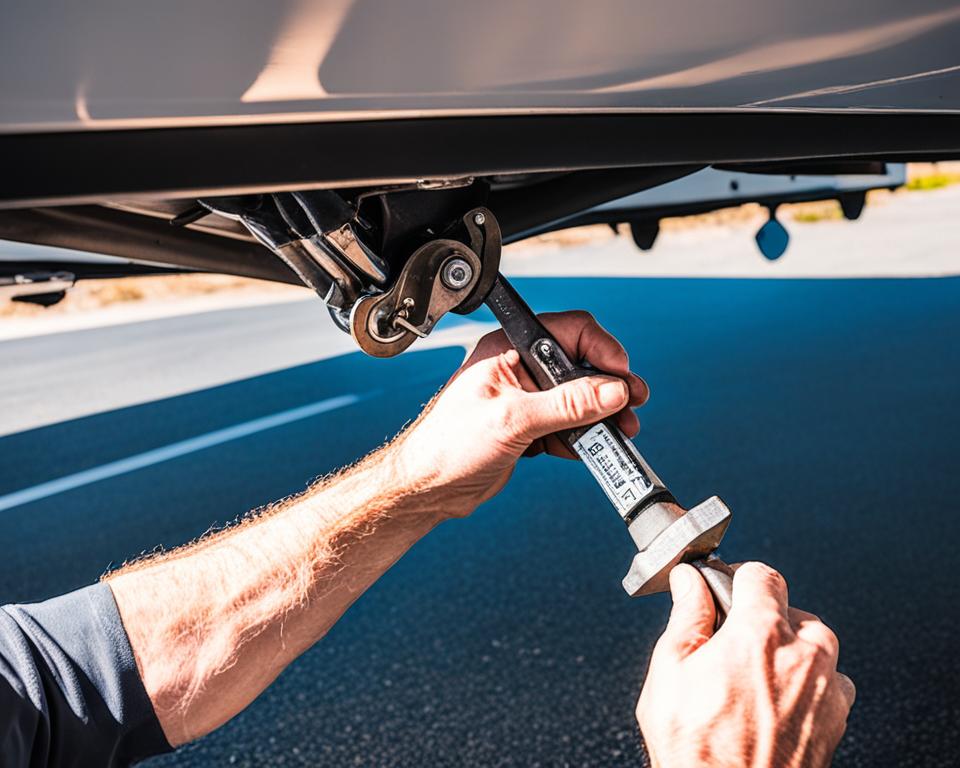
The Basics of RV Suspension Maintenance
Proper maintenance of your RV suspension is essential to ensure a smooth and safe journey on the road. RV suspension maintenance covers different areas that require regular attention and care. By understanding the basics of RV suspension maintenance and performing important tasks, you can keep your suspension system in optimal condition for years to come.
Areas Covered in RV Suspension Maintenance
RV suspension maintenance encompasses various components of your RV, including:
- Water Systems and Plumbing: Regularly check for leaks, inspect water lines and connections, and clean filters and vents to ensure a reliable water supply throughout your RV.
- HVAC Units: Clean and maintain your RV’s heating, ventilation, and air conditioning systems to ensure efficient and uninterrupted temperature control.
- RV Exterior: Regularly wash and inspect your RV exterior for any signs of damage, such as cracks or dents. Keep the exterior clean and well-maintained to protect against weather elements and prolong its lifespan.
- Tow Vehicle Maintenance: If you have a towable RV, don’t forget to maintain your tow vehicle’s suspension and ensure it is in good condition for safe towing.
- RV Appliances and Electrical Systems: Check and test all appliances, electrical systems, and connections regularly to avoid any failures or malfunctions while on the road.
- Tires and Suspension: Inspect your tires for wear, cracks, and proper inflation. Additionally, lubricate moving parts, check suspension components for any signs of damage, and ensure proper alignment for optimal performance.
Important Tasks for RV Suspension Maintenance
To keep your RV suspension in top shape, it’s important to perform the following tasks:
- Regular Inspection: Regularly inspect all suspension components, including shocks, springs, and axles, for wear, cracks, or any signs of damage.
- Lubrication: Lubricate moving parts, such as joints and bushings, to reduce friction and maintain smooth operation.
- Tire Maintenance: Check tire pressure regularly, inspect for wear, and rotate tires as recommended by the manufacturer.
- Alignment: Have your RV’s suspension alignment checked to ensure proper tracking and even tire wear.
- Weight Distribution: Properly distribute the weight in your RV to prevent overload and excessive strain on the suspension system.
- Proactive Repairs: Address any issues or abnormalities promptly to prevent further damage and costly repairs.
By understanding the basics of RV suspension maintenance and performing these important tasks, you can ensure the longevity and optimal performance of your RV suspension system. Regular maintenance will not only enhance your RV’s overall safety and comfort but also save you from costly repairs and replacements in the future.
Common RV Suspension Problems and Maintenance Issues
As an RV owner, it’s crucial to stay informed about common suspension problems to ensure a smooth and enjoyable RVing experience. Here are some common issues that may arise with your RV suspension:
- Water Intrusion: One of the most common problems faced by RV owners is water damage. Water intrusion can lead to mold, mildew, and rotting of the RV’s structure, including the suspension components. Regularly inspect your RV for any signs of water leaks and address them promptly.
- Safety Concerns: Safety should always be a top priority when it comes to RV suspension. Issues such as tire blowouts, mechanical failures, and improper towing or driving practices can pose significant risks. Regularly check your tires for wear and damage, perform routine maintenance on your suspension system, and ensure proper driving and towing techniques.
- Lack of Working Amenities: Another maintenance issue that RV owners may encounter is a lack of working amenities. Problems with the A/C, toilets, and other essential systems can disrupt your RVing experience. Regularly inspect and maintain these amenities to ensure optimal functionality.
By staying vigilant and addressing these common problems through regular maintenance, you can prevent major issues and enjoy a smooth and trouble-free RVing experience.
Troubleshooting RV Suspension Problems
If you notice any of the common suspension problems mentioned above, it’s essential to troubleshoot and resolve them promptly. Here are some troubleshooting steps you can take:
- Diagnose the Problem: Carefully assess the symptoms and identify the specific issue with your RV suspension. This may involve inspecting the affected components, listening for any unusual sounds, or noting any changes in the RV’s handling or performance.
- Consult the Owner’s Manual: Refer to the manufacturer’s instructions and guidelines outlined in your RV’s owner’s manual. It may provide valuable insights on how to address specific suspension problems or recommend professional assistance.
- Seek Professional Help: If you’re unsure how to fix the problem or it requires specialized expertise, it’s best to consult a qualified RV service professional. They will have the knowledge and experience to diagnose and resolve complex suspension issues effectively.
- Maintain Regular Service: Preventive maintenance is key to minimizing suspension problems. Adhere to a regular maintenance schedule and perform routine inspections, lubrication, and adjustments as recommended by your RV manufacturer or professional service provider.
By taking proactive measures to troubleshoot and resolve suspension problems, you can ensure the safety, performance, and longevity of your RV suspension system.
Conclusion
Proper maintenance of your RV suspension is essential for a safe and enjoyable RVing experience. By following a comprehensive maintenance checklist and performing regular inspections and maintenance tasks, you can ensure the longevity and optimal performance of your RV suspension system. Remember to consult your RV manuals and follow manufacturer recommendations for specific maintenance tasks.
Regular inspections are crucial to identify any potential issues or signs of wear and tear. Addressing these issues promptly can prevent them from escalating into more significant problems that could lead to accidents or costly repairs. By taking proactive measures, you can maintain a smooth and comfortable ride, as well as extend the lifespan of your RV suspension.
Additionally, it’s important to stay informed about the specific needs of your RV suspension system. Different types of RVs may have unique requirements, and it’s essential to follow the appropriate maintenance guidelines for your specific model. This will ensure that you are giving your RV suspension the attention it needs to stay in top condition.
In conclusion, consistent and thorough maintenance of your RV suspension is key to a safe and reliable RVing experience. By incorporating a routine maintenance schedule and adhering to industry best practices, you can enjoy worry-free travels and make the most of your RV adventures. Happy RVing!
FAQ
What is an RV suspension maintenance checklist?
An RV suspension maintenance checklist is a list of tasks and inspections that should be performed regularly to ensure the proper functioning and longevity of the suspension system in an RV.
Why is RV suspension maintenance important?
Regular RV suspension maintenance is important because it ensures safety on the road, maintains optimal performance and efficiency, and extends the lifespan of the suspension components.
What should be included in pre-trip RV suspension maintenance?
Pre-trip RV suspension maintenance should include checking tire pressure, inspecting tires and wheels for damage, and ensuring the electrical connection between the RV and tow vehicle is working properly.
What are some monthly RV suspension maintenance tasks?
Some monthly RV suspension maintenance tasks include filling gaps in seals, cleaning and lubricating slide-outs, checking batteries and fluid levels, running and servicing the generator, cleaning the A/C unit, and testing detectors.
What should be included in seasonal RV suspension maintenance?
Seasonal RV suspension maintenance should include tasks such as washing and waxing the exterior, deep cleaning the interior, cleaning or replacing awning fabric, and getting an oil change for motorhomes.
What maintenance should part-time RVers or weekend warriors perform on their suspension?
Part-time RVers and weekend warriors should perform regular maintenance tasks such as checking tire pressure, inspecting tires and wheels, and completing the monthly and seasonal maintenance tasks mentioned earlier.
What are some RV suspension maintenance tips for beginners?
Some RV suspension maintenance tips for beginners include reading RV manuals, checking seals, cleaning and lubricating slide-outs, checking tires, running and servicing the generator, and regularly testing detectors.
What are the basics of RV suspension maintenance?
The basics of RV suspension maintenance include tasks such as checking for leaks, cleaning filters and vents, lubricating moving parts, and inspecting for wear and damage.
What are some common RV suspension problems and maintenance issues?
Common RV suspension problems and maintenance issues include water intrusion, safety concerns such as tire blowouts and mechanical failures, and lack of working amenities like A/C and toilets.
What is the importance of proper RV suspension maintenance?
Proper RV suspension maintenance is important for a safe, comfortable, and enjoyable RVing experience. It helps ensure the longevity and optimal performance of the suspension system.



